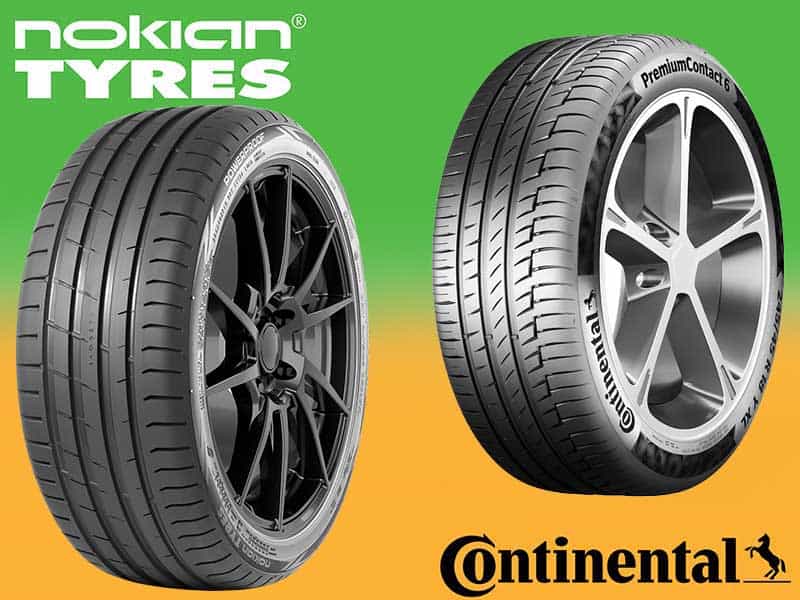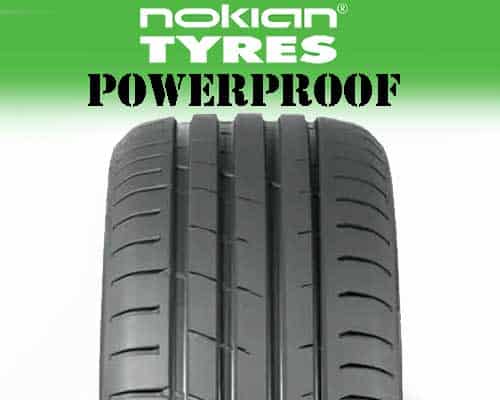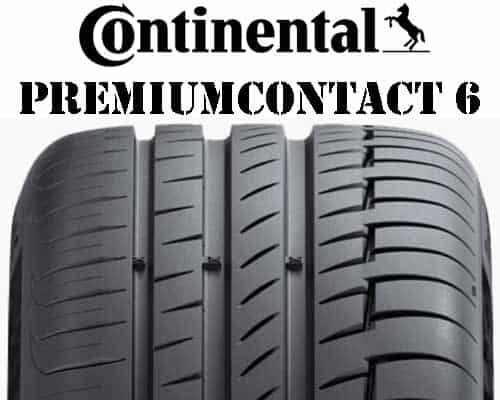Nokian Powerproof vs Continental Premium Contact 6: High performance tires are developed for powerful sports cars. So they have the best traction values and amazing steering response. And both these tires seem to be doing a great job at that.
Continental needs no introduction, but in case you are wondering about the other tire…

Examine the treads on these tires closely. They hold the key to knowing which to choose. In fact if you visit my "tread design" page, picking the right tire would never bother you.
Nokian is a prominent brand in the tire manufacturers industry. Headquartered in Finland, Nokian is famous for producing high-quality winter tires. However, in recent years, there has been a surge in the popularity of their summer tires as well.
Let’s go straight to the comparison.
Table of Contents
Comparing Nokian Powerproof & Continental Premium Contact 6

Vs

Simply put, overall the PremiumContact 6 has a better traction on both wet and dry asphalts.
Side Note: Still, the Michelin Pilot Sport 4 has better traction than PremiumContact 6.
And Nokian Powerproof leads in rolling resistance, comfort (in terms of noise), and is cheaper.
Traction is a two part score mostly, where one thing is the grip of the tire on the road and the second is the handling of tire. Continental basically did better in all wet and dry handling and grip tests.
And looking at the tread of both it really makes sense.
As the handling is mostly dependent on the outer shoulder of the tire. The PremiumConatct 6 went aggressive here. They even left out a groove. (Notice there are 4 major grooves on the Nokian where there are 3 (although wider) on Continental.
Continental tires here has better siping covering most of the shoulders. Thus cornering of the tire is better.
On the other hand, the Nokian shoulders have fewer sipes and grooves and even the shoulder area is less when compared, so it is no surprise to see it didn’t beat PremiumContinental 6 on dry and even wet handling.
Similarly speaking of braking, Continental was better at stopping the car quickly, showing more grip. This has to do with its greater surface area with the asphalt.
On the Nokian Powerproof, the contact patch with the road is less. One of the factor contributing it it the tread blocks or sections if you will. These blocks are not seen on the PremiumContact 6, instead we only see sipes on each tread pattern part.
Dry and Wet Traction Comparison:
Although the tire was not able to outperform the Continental tire, when tested, the Nokian Powerproof exhibited decent dry traction with a short dry braking distance of 35.3m (and wet braking distance of 50.3m).
The tire features an innovative dual-zone safety technology designed to provide drivers with the best combination of dry and wet properties. This dual-zone safety feature plays an important role in improving the tire’s dry traction, even when the vehicle is maneuvering or brakes are suddenly pressed.
The Nokian Powerproof displayed good cornering on a wet surface too. The Nokian Powerproof is ideal for those who live in rainy areas since they perform well even on wet highways, making them perfect for daily use. However, the Powerproof gave relatively weaker feedback on a wet surface than a dry one.
For this reason, we found its capacity to grip dry surfaces at a slow or high speed to be good. However, a slight wheel spin was noted when the vehicle was driven at high speed, despite its logical steering feature designed to facilitate high-speed lane changes.
Unlike its counterparts, the Nokian Powerproof allowed no tramlining. This was a feature of the tire that stood out to us the most as it allows the driver more control of the vehicle.
We also noted the tires tended to understeer a little on dry surfaces since their soft sidewalls can negatively impact road feedback. While it performed well around corners and exhibited decent dry grip, we found its steering not to be as precise as its counterparts.
On the other hand for PremiumContact 6 performs extremely well when it comes to dry handling and dry braking. This means that it is easy to steer on a regular, dry road and also comes to a halt steadily and also quickly if needed.
Among UHP tires, the Contact Premium 6 stands out. Its dry traction is exceptional for a UHP tire. It also gives the drive a very sporty feeling. Under dry traction testing, these tires perform remarkably well during the first lap. Afterwards, however, as the heat builds up, it slows down a little. This proves that even though it is a summer tire, it may not be the best option under very high climate conditions.
The dry handling time of these tires is 94.83 seconds. Its dry braking in meters (from 100 km/h to 1 km/h) is 34.27 meters. Its dry handling time, especially, is comparable with that of UUHP tires. This is because of its tire shoulder configuration and asymmetrical tread rib geometry, which add additional grip, especially when cornering.
Side Note: In terms of wet grip of the tire, nothing beats the Hankook Ventus S1 Evo3.
Hydroplaning/Aquaplaning:
When tested, the Continental PC 6 better wet performance with although lesser no. of circumferential grooves but still having a greater capability to evacuate water quickly.
78 km/h float speed was for the Continental PC6 where it was 72 km/h for the Nokain Powerproof.
Similary, its no surprise that the aquaplaning on the curves is also better on Continental tire here.
The Nokian Powerproof were designed to improve the hydroplaning resistance of the Nokian tires. This claim was not well-founded as we did not find its hydroplaning resistance to be at par with its counterparts.
Despite the Powerproof’s good tread life and wet grip, its hydroplaning resistance was not as strong. For this reason, we would not recommend using it on slippery surfaces or in the middle of a heavy downpour.
Comfort
The noise level of 71 dBs for the Nokian tire where the other had 73.5 decibles.
Nokian Powerproof tires proved to be one of the quietest tires on the market. When tested, an external quiter noise was recorded. However, the tires did provide a very comfortable ride especially in the beginning stages of its use.
In terms of noise, Pirelli P zero PZ4 did the best out of all the tires we compared.
Conclusion
Continental PremiumContact 6 is better in overall dry and wet traction so you get a better performance here, with better handling times and over better grip.
But NokianPowerproof, in addition to being a lot cheaper, and with still decent enough performance values can not be ignored at all.




